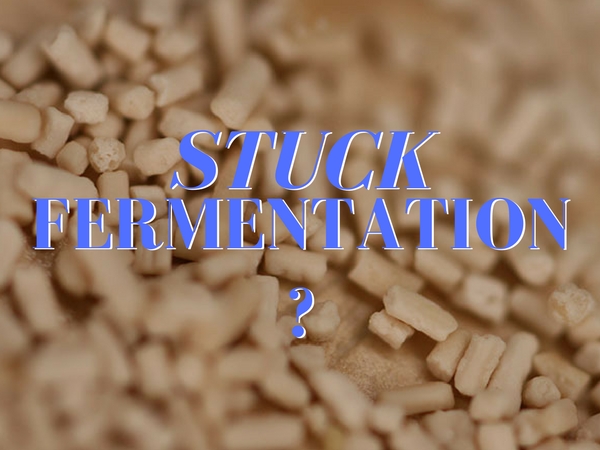What Causes A Stuck Fermentation & How To Prevent It Happening
One of the most common questions I see from new home brewers is about stuck fermentations. Basically, any beer that fails to completely finish fermenting or reach the desired final gravity, sometimes one that fails to even start fermenting.
The question basically goes something along these lines, “My beers stop fermenting and it’s still at 1.028, what is going on?”.
The gist of it is that you brew the beer, pitch the yeast and one of the following things happen:
The beer stops fermenting before the target final gravity.
Or
The beer starts fermenting sluggishly and stalls or doesn’t really start at all.
These are both technically stuck fermentations however they are not necessarily caused by the same things so there are some important distinctions to make. In this article, we are going to look at some of the possible causes for each type of stuck fermentation and ways to prevent them happening in the first place.
Table of Contents
Fermentation That Never Properly Starts
A non starting fermentation is still a stuck fermentation but the reasons why it never starts properly in the first place may be different to a fermentation that stalls toward the end. As you might guess most of the reasons point to the yeast and the factors that affect yeast health so let’s start with the basics and work onward from there.
One thing to point out here is that just because the airlock isn’t bubbling it doesn’t mean the beer isn’t fermenting. The only real way to check the state of a fermentation is with a hydrometer reading.
The Viability and Quality of Yeast
This is the first thing to look at if the fermentation starts sluggishly and then gets stuck or fails to even start. Every package of yeast you buy will have either a production date or a use by date. This information is vital in telling you whether you are pitching healthy, viable yeast cells or simply poor quality and dead yeast cells. If you have had a package of yeast for a while it may be that the viability of cells has dropped too low so there aren’t enough healthy yeast when pitched into your wort to properly start fermentation.
You can read more about yeast viability over here, this can easily be prevented however by making a yeast starter before pitching the yeast. A starter a day before the brewday will tell you whether you have healthy and active yeast before you even make the beer. Check these instructions on making a yeast starter or these on rehydrating dry yeast.
If you have a packet of yeast that’s old or a dud, repitching a new package should start the fermentation as normal.
Temperature Of The Wort
This is the next thing on the checklist if you are having a painfully slow, non starting fermentation or stuck fermentation. If the temperature inside the fermenter is too low it can inhibit the yeast activity. Different strains of yeast work best at differing temperature ranges. If you leave the fermenter in a cold garage it may be too cold for the yeast to become active.
Ideal temperature ranges for most ale yeasts are around 18°C – 21°C, lagers are lower at around 7°C – 14°C. If your beer is sitting in too cold of a spot then it is likely the yeast will be struggling to get going.
Similarly, higher temperatures will have potential to cause problems. If you pitch the yeast whilst the temperature of the wort is still too hot there is the possibility that these higher temperatures will actually kill the yeast, in this case, fermentation will have no chance of even beginning.
If the fermenter is in a spot that is likely to fluctuate in temperature or fall out of the ideal range of the yeast move it to somewhere more suitable. If you think you may have pitched the yeast into too hot a wort you will need to repitch new, healthy yeast.
Lack of Oxygen in the Wort
Yeast cells need oxygen to reproduce. This is why you are advised to aerate the wort as it is going into the fermenter.
Most brewers rely on splashing or movement to aerate the wort as it is poured into the fermenter, this is the simplest way to introduce oxygen needed by the yeast. Other brewers use aeration devices on a drill for example, to whip air into the wort and some even use pure oxygen through an aeration stone.Most brewers can make do with aerating by pouring the wort from a height to get oxygen into solution but as the gravity of a beer rises the additional stresses put on the yeast can mean a lack of oxygen can cause a stuck fermentation as there is not sufficient resources for them to reproduce.
If you skip this simple step of introducing oxygen just prior to pitching yeast it can stall the yeast, increase the lag time before the beer starts fermenting and cause a stuck fermentation. The best practice, in this case, is to aerate the wort and pitch fresh, healthy yeast.
Stuck Fermentations Prior To Hitting Final Gravity
Instances, where the beer has been fermenting normally only for it to stop before you hit the desired target final gravity, can share some of the issues above. There may also be other reasons to consider.
If the beer has been fermenting away for a few days and then slows down to a halt, you check the gravity using a hydrometer and it is higher than you were expecting, what is going on here?
First of all you need to make sure it is actually a stuck fermentation, take hydrometer readings on consecutive days and see if there is actually no movement. If there is no movement you then can confirm it’s a stuck fermentation. Now we can troubleshoot what’s going on.
Is It Possible Fermentation Has Completely Finished?
When you look at a recipe and the target gravity reads 1.012 if it finishes somewhere above this we jump to the conclusion it’s a stuck fermentation when it is entirely possible that the beer just has a higher final gravity than expected. There are a couple of reasons to consider why it may finish higher, the first thing to look at is the yeast attenuation.
Low Attenuating Yeast Strain
The attenuation of a yeast strain is a measurement that tells us what percentage of sugar available to the yeast will be converted to alcohol. A high attenuation will mean more sugar is converted to alcohol than a low attenuating yeast strain.
Use this ABV calculator to work out the percentage attenuation of your beer, you can then compare it to this yeast reference table. It may just be the case that you are using a lower attenuation yeast strain.
Mash Temperatures
One more possible cause of fermentation stopping at a higher than expected gravity can be influenced by mash temperatures. If you mash at a higher temperature than a recipe indicates there will be more long chain sugars and dextrins left in the wort. Yeast will not be able to ferment these more complex sugars and so the fermentation finishes at a higher gravity than you expect.
There isn’t a lot that can be done about this with the exception of introducing enzymes post fermentation. In most cases you will have to settle with the beer how it is.
Overly Flocculant Yeast
This trait is a lot less common and more of an issue in larger scale batches but still can happen at a home brew level, particularly if the fermenter is too cool for example.
All yeast will naturally flocculate to some degree and different yeast strains do so at different levels. Highly flocculant yeast strains will sediment to the bottom of the fermenter quickly post fermentation. If this happens too quickly however before fermentation is complete the result is a stuck fermentation.
As I mentioned this is not common at home brew scales where there is much less pressure on the yeast in a small batch. The simple solution is to rouse the yeast to get it back into suspension by stirring up the wort or to re-pitch fresh yeast.
Stuck Fermentations Are Better Prevented Than Cured
The best way to avoid stuck fermentations of any sort is to concentrate on yeast health and providing the best possible environment for yeast to reproduce and flourish.
In practical terms this means; making a yeast starter, ensuring yeast viability and ensuring the wort has adequate aeration, nutrition and is held at the correct temperature for the yeast strain. If something does go wrong for some reason it will be due to one of the above factors so try to give you yeast no reason to stop halfway through the job.





Leave a Reply
Want to join the discussion?Feel free to contribute!